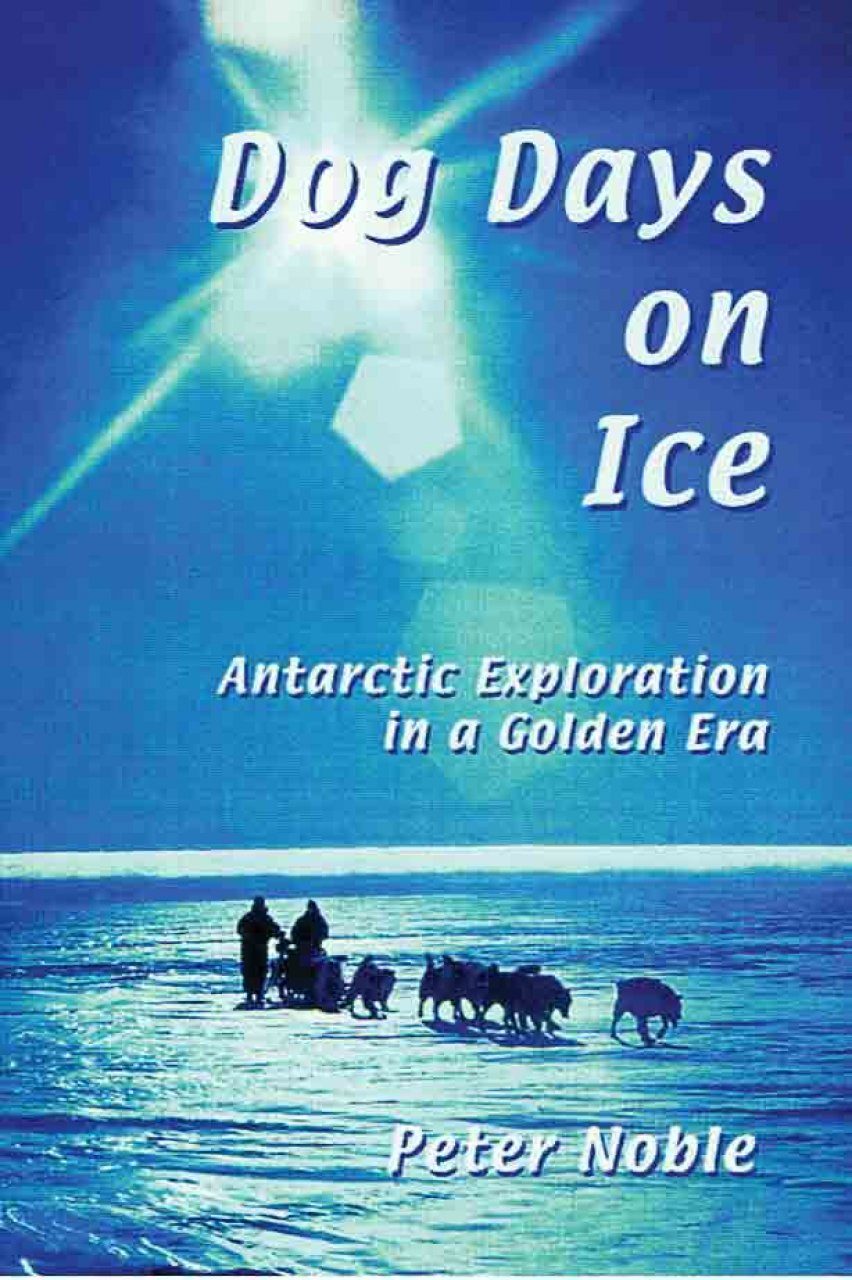

Dog Days on Ice: Antarctic Exploration in a Golden Era by Peter Noble. Cheltenham, Reardon Publishing, 2008, 231 pp (paperback). ISBN 1 873877 89 7. Price £14.99.
Review by Peter Clarkson
Peter Noble was a General Assistant at the British Antarctic Survey (BAS) station Halley Bay for the 1967 and 1968 winters. This is his personal story of his time on base and in the field during those two years. The book comprises an introduction, 21 chapters, an Epilogue and six appendices. There are colour maps on the inside front (Weddell Sea region) and back (Coats Land) covers, the latter is also repeated in monochrome in the text, and a map of the Brunt Ice Shelf. Seven line diagrams illustrate topics mentioned in the text and there are numerous small line drawings scattered through the book. These last are not acknowledged so they are presumably by the author. Finally there are two sets of colour photographs, each of eight pages, illustrating various aspects of the book but mainly field activities.The central theme of chapters 2 to 18 is the author's return with Mike Skidmore and the Hairybreeks dog team from Point Touché, their closest approach to the eastern Shackleton Range on the reconnaissance journey to reach the range in the 1967-68 austral summer. On the face of it, this may sound a rather tedious tale but far from it. The author digresses frequently as events and thoughts during the journey are introduced to describe various other aspects and incidents of life at Halley Bay during his two-year stay. Some of these describe the minutiae of life on base or in the field, especially with respect to driving dogs, that are often omitted from other accounts. These provide the flesh to the bones of the story that will prompt memories of similar occasions in every Antarctic reader. Through the book nine of the author's many "Poems, rhymes and songs" have been reproduced to provide a more humorous perspective on some of the events described.
Chapters 19 and 20 focus on base life during winter: preparation of Nansen sledges, tents, and general field equipment for the coming field season. They also tell of the frustration felt by the field personnel during the 1968 winter when the Shackleton Range was deemed to be too far to support mountain field parties in the same season and the proposed alternative, geology in Vestfjella, was later cancelled because the Americans had already agreed to fly a Norwegian field party to those mountains. Eventually it all came good. The Americans flew a survey and geological party from Halley Bay into the Shackleton Range while the author led a tractor traverse to the eastern end of the range. The tractor trip, the largest and longest ever undertaken by BAS is described in Chapter 21. Four tractors pulled 12 sledges loaded with up to 29 tonnes, including a living caboose with bunks for all six men. The total return distance travelled was some 1000 miles, although none of the vehicles were driven the full distance; the International Harvester bulldozers were depoted 395 miles from Halley Bay and the Muskeg tractors were carried on sledges behind the Internationals for 340 miles of the return journey. The result of the trip was the laying of an enormous depot in the eastern Shackleton Range that was a vital supply for field parties flown into the western end of the range in subsequent seasons. In addition, the map made of the area and the rock specimens collected provided valuable information for the geologists and surveyors until they could reach the area for themselves.
The appendices provide valuable supplementary information to the author's personal story and also to the larger history of dog-sledging from Halley Bay. Appendix 1 lists the "Personae Dramatis of the Dog Days (1961-72)"; Appendix 2 lists "Field Expeditions from Halley Bay - 1957 to 1972". Appendix 3 "Halley Bay Huskies", comments on the practices of using dogs, lists all the Halley Bay dogs with a statistical analysis and a note on naming dogs. Appendix 4 "Field Rations", lists the food box contents and suggested extras while Appendix 5 "PO Bag and P Bag", includes lists of personal field living equipment and clothing that is normally carried. Appendix 6 is a useful glossary of terms used. An index would have been useful.
Describing the period as "a Golden Era" is a touch romantic but no doubt many who experienced it will agree. It was certainly a unique period that formed a link between the Heroic Era of Antarctic exploration and the modern era of scientific investigation with its rigid planning, financial constrictions and Health and Safety regulations. Some readers may prefer a stricter chronological account but this is a personal story and the style works well. There are criticisms of BAS but the strongest criticisms are reserved for the dog drivers, including himself, and the general treatment of the dogs. In most cases the latter are fully justified because practices founded largely on ignorance were passed on from year to year; nobody ever attended a training course for sledging with huskies. With hindsight, a school report on most dog drivers might have been marked "could have done better". An irritation is the number of names of people and places that are spelled incorrectly.
All in all this is a good book that should be eagerly read by all those who were there at the time and by anyone who is looking for a personal account of living and exploring in Antarctica when dog-sledging reigned supreme.
Peter Clarkson
November 2008
The book is now available through bookshops, or direct from the publisher at www.reardon.co.uk. Alternatively it may be ordered (postage-free) direct from the author via peter@kingsburysquare.org.uk, payment by Paypal. Due to recent increases in postage and packing, the price to fids is now £14 (UK), £16.50 (Europe), £20.00 (rest of world) - or £12 at the BAS Club Reunion.